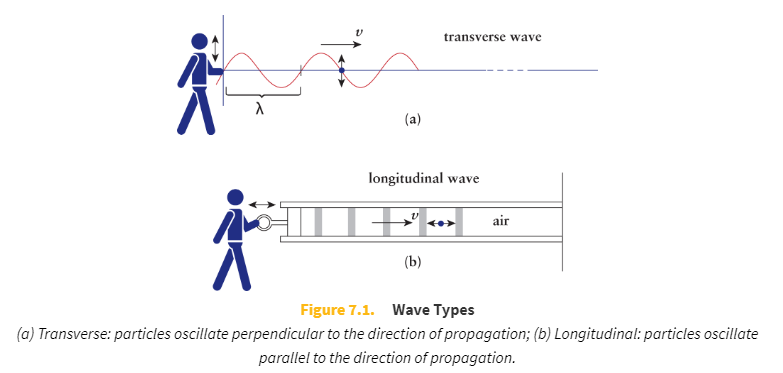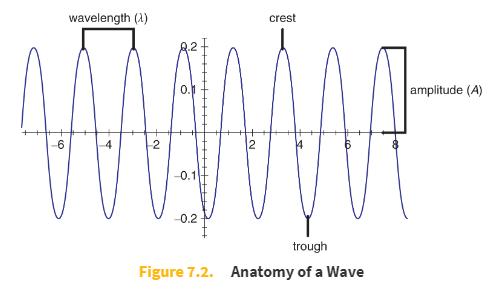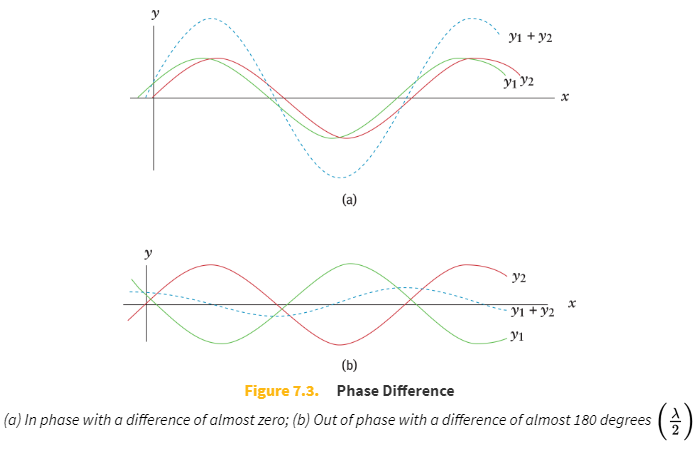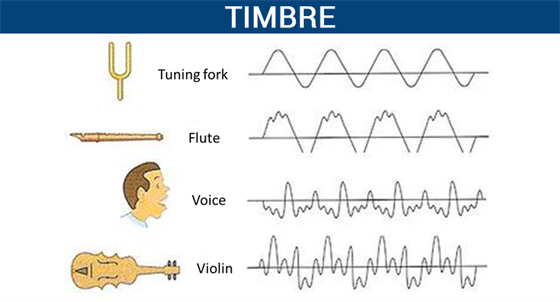-
Sinusoidal waves
In sinusoidal waves, which may be transverse or longitudinal, the individual particles oscillate back and forth with a displacement that follows a sinusoidal pattern.
-
Transverse waves
Transverse waves are those in which the direction of particle oscillation is perpendicular to the propagation (movement) of the wave.
-
In any waveform, energy is delivered in the _____.
direction of wave travel
-
Longitudinal waves
Longitudinal waves are ones in which the particles of the wave oscillate parallel to the direction of propagation; that is, the wave particles are oscillating in the direction of energy transfer.
-
Rarefaction
Rarefaction is the reduction of an item's density, the opposite of compression.
a.k.a decompression
-
Transverse waves have particle oscillation _____ to the direction of propagation and energy transfer. Longitudinal waves have particle oscillation _____ to the direction of propagation and energy transfer.

perpendicular
parallel
-
wavelength (with symbol)
The distance from one maximum (crest) of the wave to the next is called the wavelength (λ).
-
frequency (with symbol)
The frequency (f) is the number of wavelengths passing a fixed point per second, and is measured in hertz (Hz).
-
Hertz
cycles per second (cps)
-
Propagation speed equation
ν = fλ
-
Period
Period (T) is the number of seconds per cycle
-
Period equation

-
Angular frequency equation

-
Angular frequency units
radians per second
-
Equilibrium position
Waves oscillate about a central point called the equilibrium position.
-
displacement in a wave
The displacement (x) in a wave describes how far a particular point on the wave is from the equilibrium position, expressed as a vector quantity.
-
Amplitude
The maximum magnitude of displacement in a wave is called its amplitude (A).
-
Label the wavelength, crest, trough, and amplitude of a wave

-
Phase difference
The interval by which a wave leads by or lags by another wave.
-
We can say that two waves are in phase if ...
... their respective crests and troughs coincide (line up with each other).
-
When waves are perfectly in phase, we say that the phase difference is _____.
zero
-
We would say that two waves are out of phase if ...
the two waves travel through the same space in such a way that the crests of one wave coincide with the troughs of the other.
-
When waves are perfectly out of phase, their phase difference is _____.
one-half of a wave
Can also be expressed as λ/2 or, if given as an angle, 180°
-
Principle of superposition

The principle of superposition states that when waves interact with each other, the displacement of the resultant wave at any point is the sum of the displacements of the two interacting waves.
-
Constructive interference
When the waves are perfectly in phase, the displacements always add together and the amplitude of the resultant is equal to the sum of the amplitudes of the two waves. This is called constructive interference.
-
Destructive interference.
When waves are perfectly out of phase, the displacements always counteract each other and the amplitude of the resultant wave is the difference between the amplitudes of the interacting waves. This is called destructive interference.
-
If two waves are perfectly in phase, the resultant wave has an amplitude equal to _____. If two equal waves are exactly 180 degrees out of phase, then the resultant wave has an amplitude equal to _____.
the sum of the amplitudes of the two waves
zero
-
If waves are not perfectly in phase or out of phase with each other, _____ or _____ interference can occur
partially constructive
partially destructive
-
Traveling wave

A wave in which the medium moves in the direction of propagation
-
Standing waves

A wave that oscillates in time but whose peak amplitude profile does not move in space
-
Nodes
Points in a standing wave that remain at rest (where amplitude is constantly zero) are known as nodes.
-
Antinodes
Points midway between nodes fluctuate with maximum amplitude and are known as antinodes.
-
Examples of structures that can host standing waves
A string with two fixed ends
A pipe with both sides open
A pipe with one side open
-
Natural (resonant) frequencies
The frequency at which a system tends to oscillate in the absence of any driving force
-
Which objects have resonant frequencies?
all objects
-
Timbre

The characteristic waveform of sound that depends on the material from which it produces
-
Some objects vibrate at a single frequency, producing a _____.
pure tone
-
Noise
Some objects vibrate at multiple frequencies that have no relation to one another. These objects produce sounds that we do not find particularly musical, such as tapping a pencil, hitting a chair, or crumpling paper. These sounds are called noise, scientifically.
-
Some objects vibrate at multiple natural frequencies (a _____ and multiple _____) that are related to each other by _____, producing a richer, more full tone.
fundamental pitch
overtones
whole number ratios
-
Hearing range of healthy young adults
between 20 Hz and 20,000 Hz
-
High-frequency hearing generally _____.
declines with age
-
Strings have an infinite number of natural frequencies that depend on the _____, _____, and _____ of the string.
length, linear density, and tension
-
Forced oscillation
If a periodically varying force is applied to a system, the system will then be driven at a frequency equal to the frequency of the force. This is known as forced oscillation.
-
If the frequency of an applied force is close to that of the natural frequency of the system, then the amplitude of oscillation _____.

becomes much larger
-
Force frequency
The frequency at which a periodically varying force is applied to a system.
-
Damping or attenuation
In general, damping or attenuation is a decrease in amplitude of a wave caused by an applied or nonconservative force.
-
Many objects cannot withstand the large amplitude of oscillation of a periodically applied force and will _____.

break or crumble
-
Resonance
Resonance describes the phenomenon of increased amplitude that occurs when the frequency of an applied periodic force is equal or close to a natural frequency of the system on which it acts.
-
If an oscillating system were frictionless, then a periodically varying, resonant force would continually add energy to the system, and the amplitude would _____. However, because no system is completely frictionless, there is always some damping, which results in a _____.
increase indefinitely
finite amplitude of oscillation

